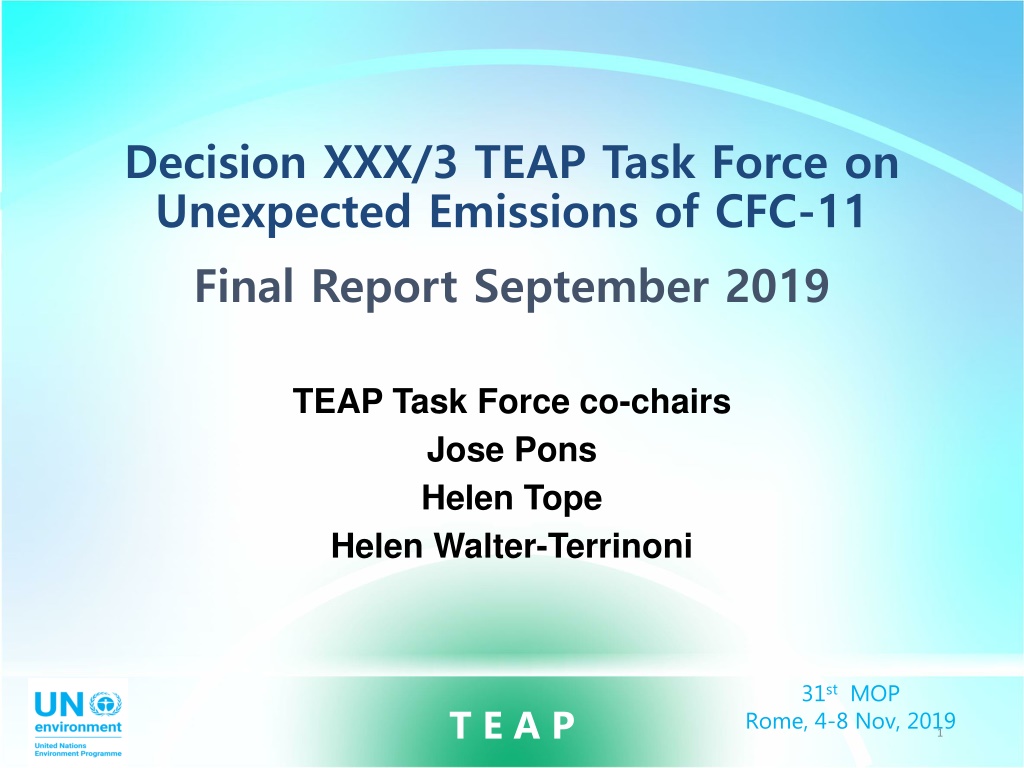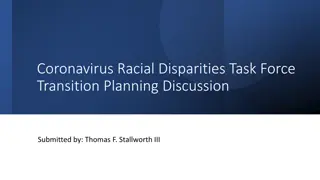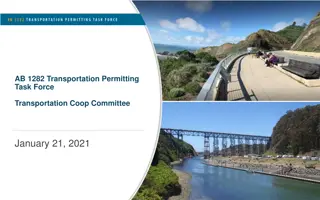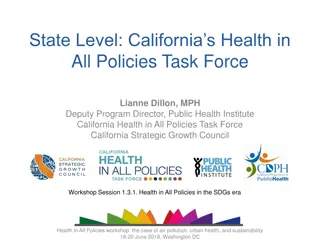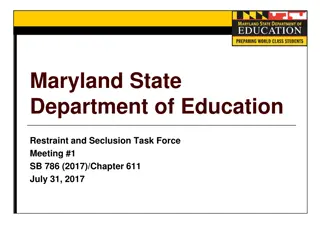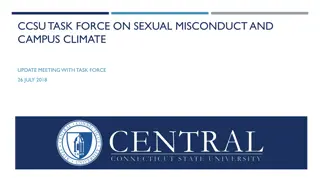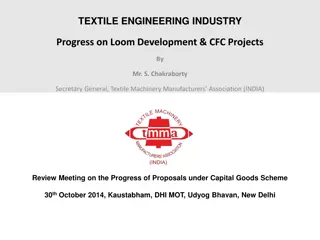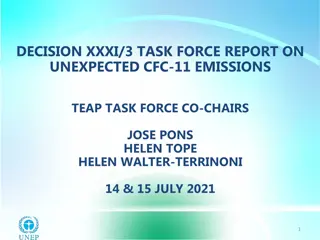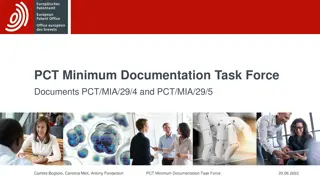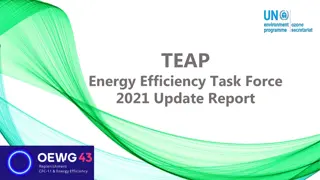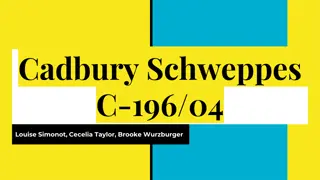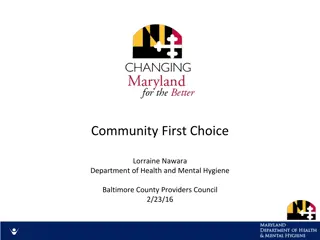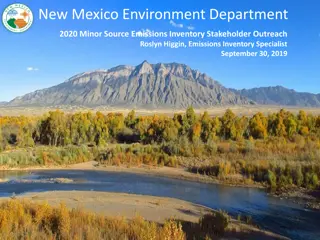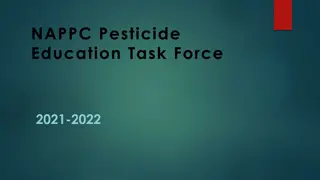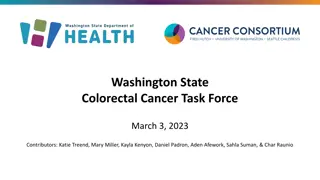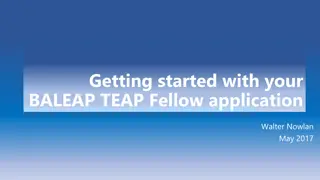TEAP Task Force Report on Unexpected Emissions of CFC-11
TEAP Task Force Report highlights the unexpected increase in global emissions of CFC-11 post the Montreal Protocol phase-out date. The report requests information on emission sources and controls, with preliminary and final reports submitted by various countries. The Final Report analyses production, usage, and emission levels, addressing concerns and providing insights on newly produced CFC-11. Consultation with experts and parties contributes to a comprehensive overview presented at the 31st MOP session in Rome.
Download Presentation

Please find below an Image/Link to download the presentation.
The content on the website is provided AS IS for your information and personal use only. It may not be sold, licensed, or shared on other websites without obtaining consent from the author.If you encounter any issues during the download, it is possible that the publisher has removed the file from their server.
You are allowed to download the files provided on this website for personal or commercial use, subject to the condition that they are used lawfully. All files are the property of their respective owners.
The content on the website is provided AS IS for your information and personal use only. It may not be sold, licensed, or shared on other websites without obtaining consent from the author.
E N D
Presentation Transcript
Decision XXX/3 TEAP Task Force on Unexpected Emissions of CFC-11 Final Report September 2019 TEAP Task Force co-chairs Jose Pons Helen Tope Helen Walter-Terrinoni 31st MOP T E A P Rome, 4-8 Nov, 2019 1
Decision XXX/3: Unexpected Emissions of CFC-11 Noting the recent scientific findings showing that there has been an unexpected increase in global emissions of trichlorofluoromethane (CFC-11) since 2012, after the consumption and production phase-out date established under the Montreal Protocol 2. To request the Technology and Economic Assessment Panel to provide the parties with information on potential sources of emissions of CFC- 11 and related controlled substances from potential production and uses, as well as from banks, that may have resulted in emissions of CFC-11 in unexpected quantities in the relevant regions; a preliminary report should be provided to the Open-ended Working Group at its forty-first meeting and a final report to the Thirty-First Meeting of the Parties; ---------------------- A submission was received from China for the preliminary report. Following the OEWG, additional information was submitted by China, the European Union, Japan, Mexico, Russia, and the United States for the final report . 31st MOP T E A P Rome, 4-8 Nov, 2019 2
TEAP Task Force Members Affiliation Party Members Affiliation Party Jose Pons MCTOC member Venezuela Enshan Sheng Huntsman Singapore Helen Tope MCTOC co-chair Australia David Sherry Nolan Sherry & Assoc. Ltd. UK Helen Walter-Terrinoni FTOC co-chair USA Sidi Menad Si-Ahmed TEAP Senior Expert Algeria Paulo Alto FTOC co-chair Brazil Peter Sleigh Mexichem UK Ltd. UK Paul Ashford FTOC member UK Christina Theodoridi NRDC Greece Nick Campbell MCTOC member France Shiqiu Zhang TEAP Senior Expert PRC Marco Gonzalez TEAP Senior Expert Costa Rica Consulting Experts Affiliation Party Dave Godwin RTOC member USA Angela Austin FTOC member UK Jianxin Hu MCTOC member PRC Andy Lindley MCTOC member UK Rabinder Kaul SRF Limited India Archie McCulloch Retired private consultant UK Lambert Kuijpers RTOC member Netherlands Steve Montzka NOAA USA Richard Lord Carrier USA Matt Rigby University of Bristol UK Bella Maranion TEAP co-chair USA Susan Solomon MIT USA Keiichi Ohnishi MCTOC co-chair Japan Guus Velders Utrecht University Netherlands Fabio Polonara RTOC co-chair Italy Dan Verdonik HTOC co-chair USA Miguel Quintero FTOC member Colombia T E A P 31st MOP Rome, 4-8 Nov, 2019
Overview of Final Report Final Report builds on the Preliminary Report: Uses additional information to complete the analysis, and to confirm or update assumptions. Considers questions raised at the 41st OEWG. Analyses CFC-11 production, usage, banks and emissions at the global and regional levels, eliminates unlikely emissions sources, identifies likely emissions sources and estimates the quantity of newly produced CFC-11 to supply them. Provides additional information on marketing and illicit international trade. 31st MOP T E A P Rome, 4-8 Nov, 2019 4
Background (1) CFC-11 was used as a foam-blowing agent (for open and closed cell foams), aerosol propellant, refrigerant (for centrifugal chillers), and in smaller uses, e.g., asthma inhalers, tobacco expansion. Alternatives replaced former uses. CFC-11 production/consumption in non-A5 parties was phased out in 1996, with some limited exceptions, e.g., for basic domestic needs CFC-11 production/consumption in A5 parties was phased out in 2010. Some A5 parties were funded to complete their phase-out earlier. Over time, CFC-11 is released into the atmosphere from banks of CFC-11 produced prior to the phase-out. These banks are made of CFC-11 remaining in closed cell foams and centrifugal chillers. 31st MOP T E A P Rome, 4-8 Nov, 2019 5
Background (2) Montzka et al. (Nature, May 2018) reported an unexpected, global increase in CFC-11 emissions of 13,000 5,000 tonnes/year after 2012 cf. 2002-2012 from the northern hemisphere. The study suggests: There is a concurrent increase in CFC-11 emissions from eastern Asia, although the regional contribution to the global increase was not quantified. The increase in CFC-11 emissions arises from new post-2010 production that has not been reported to the Ozone Secretariat. Rigby et al. (Nature, May 2019) reported increased CFC-11 emissions from eastern mainland China of 7,000 3,000 ( 1 standard deviation) tonnes/year in 2014-2017 compared with 2008-2012 These arise primarily from Shandong and Hebei provinces, accounting for at least 40-60% of the global increase in CFC-11 emissions. There was no evidence for any significant increase in CFC-11 emissions for those other countries or regions that were adequately monitored by atmospheric measurements. T E A P 31st MOP Rome, 4-8 Nov, 2019 6
Pre-2010 production and usage is unlikely to account for CFC-11 emissions A wide range of scenarios was developed to investigate the broadest possible quantities of potential emissions from pre-2010 production and usage. The Task Force was able to identify a reasonable set of plausible assumptions for a most likely bottom-up emissions scenario, based on pre-2010 CFC-11 production, prior installation of foams/RAC, existing foams/RAC banks, and end-of-life management. The emissions scenarios estimated from pre-2010 production, usage, and banks do not account for the increased atmospheric-derived emissions. Based on Task Force analysis of CFC-11 production, usage, emissions and comparison against atmospheric-derived emissions, it is unlikely that pre-2010 production and usage can account for the unexpected CFC-11 emissions without new CFC-11 production and usage. T E A P 31st MOP Rome, 4-8 Nov, 2019 7
Most likely scenario of bottom-up CFC-11 emissions: Figure 6.10 The blue ribbon shows global atmospheric-derived emissions , and represents the range from 2018 SAP Assessment Report. The green line shows the most likely scenario estimate of expected global emissions from past production, usage and existing banks. 31st MOP T E A P Rome, 4-8 Nov, 2019 8
Task Force Quantification of Emissions Montzka et al. (2018) describes a change in atmospheric derived emissions (the ribbon) in different time periods, from 2014-2016 compared to 2002-2012. The Task Force report describes the difference between the most likely expected emissions (the line) compared to the atmospheric-derived emissions from SAP Assessment Report (2018) in the same time period. 31st MOP T E A P Rome, 4-8 Nov, 2019 9
Pre-2010 CFC-11 usage in closed-cell foam by region Prior to 2010, most closed-cell foams were produced and used in Europe and North America (prior to 1996). Therefore, most of the global CFC-11 emissions occurred during foam manufacturing and installation, and during the lifetime of products containing those foams, within Europe and North America. The majority of the closed-cell foams in these regions at end of life was landfilled or destroyed locally, with low emissions. There are significant quantities of CFC-11 closed-cell foams still in buildings in Europe and North America as banks. The Final Report includes analysis of CFC-11 emissions from closed- cell foams at their end of life based on available information in all regions, which includes extreme and unlikely scenarios. 31st MOP Rome, 4-8 Nov, 2019 10
Total closed-cell foam production by region (up to 2006) North America Europe 31st MOP Rome, 4-8 Nov, 2019 11
CFC-11 emissions from regional foam banks are insufficient to explain atmospheric-derived emissions Further analysis of regional banks was completed for the Final Report, incorporating the duration of foam use and the subsequent timing of emissions from dismantling foams. The Task Force found that expected emissions originating from the pre-2010 foam banks in every region are insufficient to explain the unexpected CFC-11 emissions. The Task Force concluded that the expected emissions from the pre-2010 CFC-11 foam banks in Northeast Asia are insufficient to account for the atmospheric-derived CFC-11 emissions from eastern mainland China estimated by Rigby et al. 31st MOP T E A P Rome, 4-8 Nov, 2019 12
Resumption of newly produced CFC-11 usage in closed-cell foams is likely It is unlikely that there has been a resumption of newly produced CFC-11 usage in refrigeration and air-conditioning, flexible (open-cell) foams, aerosols, solvents, feedstock, tobacco expansion and other miscellaneous applications. It is likely that there has been a resumption of newly produced CFC-11 usage in closed-cell foams. This will result in a combination of immediate CFC-11 emissions from foam installation and CFC-11 production and an increase in the foam banks, from which CFC-11 will be released over time. 31st MOP T E A P Rome, 4-8 Nov, 2019 13
Technical and economic factors could have facilitated reversion to CFC-11 in closed-cell foams There are a number of economic factors that might have encouraged the reversion to CFC-11 in closed-cell foams: Increased demand for closed-cell foams for insulation Reduced availability of HCFC-141b due to the phase-out Price increases of HCFC-141b and prices of HFCs. Reversion from other fluorocarbons to CFC-11 in closed-cell foam manufacture can be made with technical ease. 31st MOP T E A P Rome, 4-8 Nov, 2019 14
Mislabelling of polyol blends for foams could facilitate unintended usage and international trade Parties use and/or import polyol blends labelled as containing HCFC-141b and HFCs. A5 parties import up to 7,500 tonnes per year HCFC-141b in polyol blends. Polyol blends could be mislabelled, intentionally or unintentionally, and then used by a recipient without knowing which blowing agent is actually in the blend. This could result in CFC-11 emissions during foam installation in parties receiving CFC-11 polyol blends without their knowledge. 31st MOP T E A P Rome, 4-8 Nov, 2019 15
Estimated 40,000 to 70,000 tonnes/year of CFC-11 production after 2012 The Task Force estimates that 40,000 to 70,000 tonnes/year CFC-11 production is required to account for the unexpected CFC-11 emissions in each year from 2013 to 2017. Some of 40,000 to 70,000 tonnes/year of CFC-11 production will be emitted during the production process, some during the manufacture of closed-cell foams, while the remainder will be banked in foams, from which CFC-11 will be released over time. 31st MOP T E A P Rome, 4-8 Nov, 2019 16
Most likely CFC-11 production routes CTC to CFC-11/12 on a large-scale ( 50,000 tonnes/year) in an existing liquid phase plant (HCFC-22 and/or HFC-32 plant): Spare capacity to produce CFC-11 on a large-scale in HCFC-22 and/or HFC-32 plant is available in the period after 2012. Utilisation of spare capacity lowers total production costs. CTC to CFC-11 on micro-scale (100 to 2,000 tonnes/year) plants using minimal equipment (to make low grade CFC-11 for foam blowing use). Some micro-scale plants could be contributing to production, although it seems unlikely that a large number of micro-scale plants would be solely responsible for the estimated annual CFC-11 production of 40,000 to 70,000 tonnes per year. 31st MOP T E A P Rome, 4-8 Nov, 2019 17
45,000 to 120,000 tonnes/year CTC needed to supply CFC-11 production Between 45,000 to 120,000 tonnes per year of CTC would be required to supply between 40,000 to 70,000 tonnes per year of estimated CFC-11 production, depending on the proportion of co- produced CFC-12. The CTC quantity required for CFC-11 production is expected to be at the lower end of the range if, as predicted, the objective is to make CFC-11 to supply closed-cell foams. 31st MOP T E A P Rome, 4-8 Nov, 2019 18
Co-produced CFC-12 and emissions The quantity of CFC-12 co-produced with CFC-11 is dependent on the production route chosen, and how the plant is set up and operated. With CFC-11 as the target chemical, the range of CFC-12 co- production is up to 30% of total CFC-11/12 production for the most likely production routes. The assumptions used to model CFC-12 emissions indicate high underlying uncertainty. Estimates of bottom-up CFC-12 emissions and comparison against atmospheric-derived CFC-12 emissions are inconclusive. The possible fate of co-produced CFC-12 includes destruction by thermal oxidation, usage as a refrigerant and/or aerosol propellant, usage as a feedstock, and/or release to the atmosphere. 31st MOP T E A P Rome, 4-8 Nov, 2019 19
Conclusions Pre-2010 CFC-11 production and usage is unlikely to explain the increased CFC-11 emissions. Newly produced CFC-11 usage in closed-cell foams is likely to explain the unexpected increase in CFC-11 emissions. Newly produced CFC-11 usage in closed-cell foams will result in an immediate increase of CFC-11 emissions and a long-term increase of emissions from CFC-11 foam banks. The expected emissions from the pre-2010 CFC-11 foam banks in Northeast Asia are insufficient to account for the atmospheric- derived emissions from eastern mainland China in Rigby et al. An estimated 40,000 to 70,000 tonnes/year CFC-11 production would be required to supply the post-2010 foams usage and other associated emissions. 45,000 to 120,000 tonnes/year CTC would be required to supply the estimated CFC-11 production, likely at lower end of the range. 31st MOP T E A P Rome, 4-8 Nov, 2019 20
Thank You 31st MOP T E A P Rome, 4-8 Nov, 2019 21
CFC-11 Production in non-A5 and A5 Parties *AFEAS and Article 7 reported production 31st MOP T E A P Rome, 4-8 Nov, 2019 22
The Task Force included a range of scenarios. The highest and lowest emissions scenarios and largest and smallest bank scenarios are included here based on learnings from the Sensitivity Analysis which showed that the model was most sensitive to production rates and emissions from production and foams. All of the other scenarios examined fell into the range of these scenarios. These combine highest productions rates with highest and lowest emissions rates and separately lowest production rates with highest and lowest emissions rates. The outcomes of these scenarios are noted below. Range of emissions scenarios Figure A5.17 Range of Emissions Scenarios A range of scenarios was developed for the sensitivity analysis to demarcate uncertainties inherent to the model. The Task Force was able to identify a reasonable set of plausible Figure A5.18 Range of banks scenarios assumptions that are used in the most likely scenario. The range of scenarios represents the broadest range of possibilities, which are very unlikely possibilities at the range edges. 31st MOP T E A P Rome, 4-8 Nov, 2019 23 TEAP Report, September 2019, Volume 1 Decision XXX/3 TEAP Task Force Report on Unexpected Emissions of CFC-11
Most likely scenario of bottom-up CFC-11 emissions: Figure 6.10 The Task Force estimated expected emissions based on the foam markets described regionally in the 2006 FTOC Assessment Report, incorporating: The most recent information on emissions rates during foam manufacture, foam use and end- of-life. The product lifetime for each market End-of-Life Emissions Peaks As a result, there are several peaks and valleys in the expected emissions line on the graph when foams were likely dismantled for disposal or destruction. This is more apparent in the regional graphs. The regional emissions are also subject to the immediate changes in CFC-11 production reported to the Secretariat 31st MOP T E A P Rome, 4-8 Nov, 2019 24
